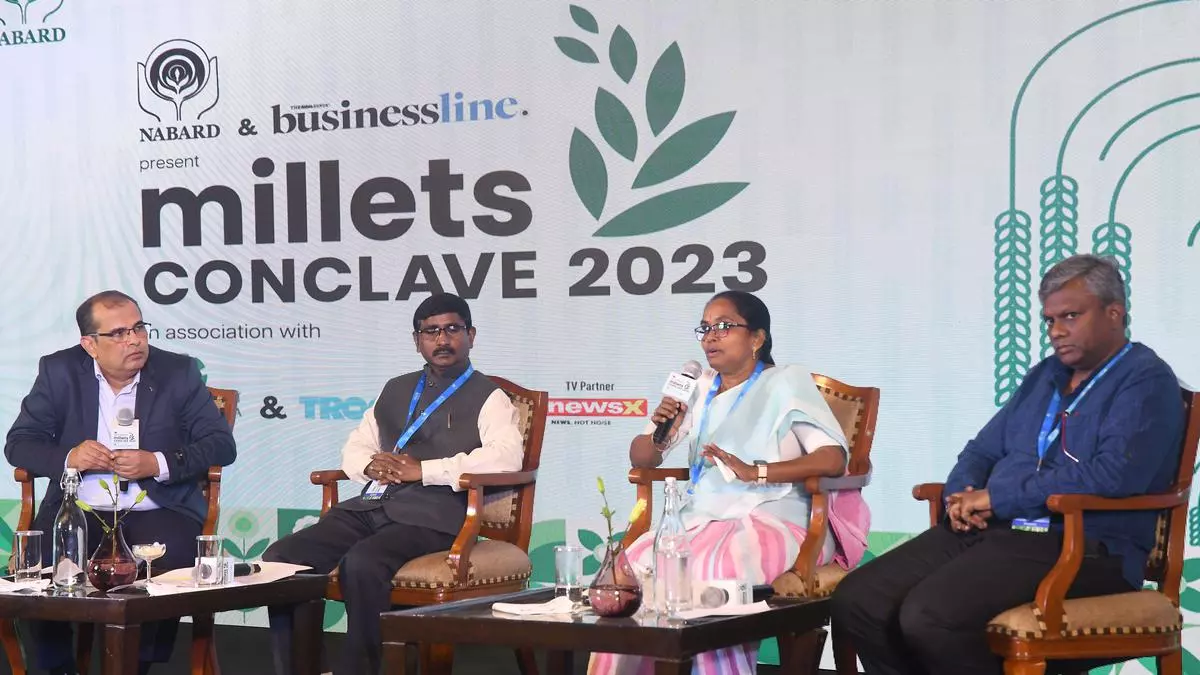‘Consumers awareness must on millets affordability factor’
The need for more awareness on millet production and consumption is the need of the hour, speakers at a panel discussion on ‘Millets for food security’ at the Millets Conclave 2023, organised by Nabard and businessline, said on Friday.
APEDA and TrooGood are the Associate Partners of the event and NewsX is the TV Partner.
Responding to a query on the affordability of millets for a common consumer, ED Israel Oliver King, Director, Biodiversity, MS Swaminathan Research Foundation (MSSRF), said people ask about the affordability from the mainstream point of view. Consumers depended on rice, wheat and to some extent maize in the last three decades.
Stating that millets may be on the higher side in terms of cost in the market, he said it cannot be compared with other crops.
Also read: Millets production set to triple by 2030: Nabard Chairman
Expanding his views, he said the recovery after processing in minor millets is about 55-60 per cent. Now with research and development innovation in processing, it has gone up to 70 per cent. That is the reason why many entrepreneurs place it on a higher side, as they have to meet the cost involved in processing. In such a situation, there is a need for creating awareness among consumers on millets, he said.
Decentralised production
A few entrepreneurs have come up in millets, he said, adding they are innovative.
The scale of production of paddy and wheat is also huge. Millets production is decentralised, and it requires specific agro-ecology for cultivation. Added to this, the transportation and other add-on costs from remote locations to consuming centres also matter.
Stating that research is on to tap untapped potential of millets, he said it is essential to be cognisant of local ecologies and local seed varieties while expanding millets cultivation.
He said MSSRF is identifying custodian farmers who are willing to cultivate, innovate and share. It is also documenting sequence and system of cropping. The foundation uses participatory appraisal of technology to increase production.
MSSRF, along with FAO, did a survey with 3,000 farmers across Asia. They all said millets have been forgotten. Now the global manifesto of forgotten foods has helped revive forgotten cuisines in millets also, and this helps in skill building, he said.
132 FPOs for millets
B Uday Bhaskar, Chief General Manger, Nabard, has said that Nabard has promoted 132 FPOs (farmer producer organisations), exclusively for millets, in India’s 14 States. Nabard has promoted around 7,000 FPOs across various agricultural commodities till now.
Terming FPO as a critical link in the millet value chain, he highlighted examples of the important role played by millet FPOs in the millet value chain.
He said Nabard has also implemented various natural resource management programmes, particularly watershed and tribal development for livelihood, covering 2 lakh hectares under millets.
Stating that the area under the millets has decreased since independence, he said now it is set to become a key crop in nutritional security.
Giving the example of Nabard’s efforts to boost cultivation in Assam, he said millet cultivation is integrated with other crops mainly in the fallow lands.
He said millet is not a water intensive crop unlike paddy. To produce 1 kg of rice, around 5,000 litres of water is required. However, only 200-300 litres of water is required to produce 1 kg of millets.
Miracle crop
Explaining the two decades of journey of her millet FPO, Saraswathi Malluvalasa, CEO, Arogya Millets Producer Co Ltd, said though villages are the food hubs, there was no food security in the rural area in the initial years.
Terming millets as the miracle crop, she said their cropping patterns in fields support biodiversity’s cropping pattern.
Mentioning that there was no availability of millet seeds when they started the work 20 years ago, she said 10 farmer clubs each were formed in the initial three years exclusively with millet farming communities. Own seed banks were developed at individual farmers level. “Now our village sisters are having surplus millets seeds in villages,” she said.
Afterwards, a campaign was started on consumption as the knowledge of its importance was vanishing from the minds of the people.
In 2016, steps were taken to form Aarogya Millet Producer Company Limited with the support of Nabard. With initial 200 members, now it has 1,430 members
On the role of millet sisters, she said millets provide five securities—food, nutrition, health, fodder, and environment. Millet sisters now have got economic security through millets, she said, adding around 200 women were trained as entrepreneurs at grassroot level.
Vishwanath Kulkarni, Deputy Editor, businessline, moderated the session.
